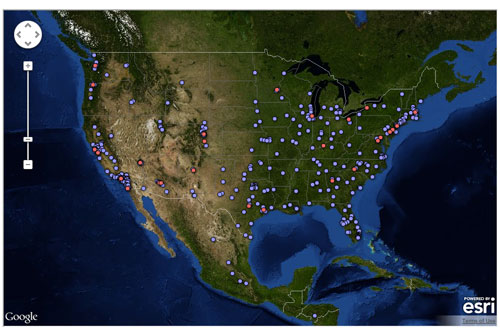
Anger arises when someone or
something has not fulfilled expectations, an injustice has been done, someone
has attacked oneself or one's idea or property, or when things are not
happening fast enough or slow enough.
We become reactive. We lose
our temper. The degree to which we "lose it" and
the nature of our behavior is influenced by the degree to
which we are mindfully aware of our thoughts, speech and actions, our ability
to control ourselves and the significance of the perceived threat.
Reactive behavior gets in the way of accomplishing objectives and
does damage to relationships. What can we do to avoid anger and, if we can't
avoid it, what can we do to moderate its effects (how can we learn to not
react)?
Managing Anger
While eliminating anger by cutting its root causes may be possible
it is most practical to learn to effectively manage anger when it does
arise.
To manage anger understand its source, recognize and acknowledge it
and then step back from the feelings and choose a course of action.
The source of anger is within. It may be triggered by external
events but its cause is internal. This is clear when we remember times when we
became angry about something that at other times did not "make us
angry." This understanding makes it possible to look inside and
manage anger without blaming it on anyone or anything else. We don't need to
change the world around us. We have to change ourselves.
Admitting to anger is difficult for some people. But difficult or
not it is necessary. Unacknowledged, anger may be suppressed, resulting in
physical and psychological issues, including gastrointestinal and breathing
problems. Suppressed anger tends to build up and then burst out in overreaction
to a minor incident.
What does anger feel like to you? Where in your body does it
manifest? Is it a tightening of the stomach or jaw; a change in the
breath? The earlier in its arising you recognize it, the more likely it
is that you can avoid reacting to it.
The next step after recognition and acknowledgement is acceptance.
In accepting anger we go beyond simplistic notions that experiencing anger is
sinful or bad. Experiencing anger is part of being human.
Identifying with anger, "being angry", and acting anger
out are unskillful and can be controlled.
Choosing a Response
With anger understood as a self generated emotion, recognized and
accepted the next step is to decide what to do about it.
One choice is to explore its source in oneself. Seeing the
underlying cause in oneself cuts the root of the anger and eliminates or at
least makes the feelings manageable. Ask "What am I bringing to
this situation?"
But there is the external the trigger. Someone has done something
that has "made you angry". Do you just let it pass while you manage
the anger by yourself?
Maybe that is the best thing to do. Perhaps the threatened belief
or mental model is not one you want to keep. Maybe the person whose behavior
got you angry didn't mean anything by it. Maybe the perceived injustice is
unavoidable. By fully experiencing and seeing the internal source of your anger
you can let it go. It is not suppressed, it passes. Like everything else, anger is temporary.
Of course, you can feed it and make it last for years, but how effective is
that as a strategy?
On the other hand, confronting behavior that gives rise to anger
may be the better choice. Often there is no good reason to be a
victim or to remain passive in the face of injustice.
If action is the better choice then take action consciously.
Reactive behavior is generally less effective than responsive behavior. Use the
energy aroused by your anger to fuel clear thinking and skillful action rather
than to just be expressed unconsciously based on your habitual way of dealing
with anger.
Your habitual way may be denial, passive aggressive or aggressive.
You may seethe and plot over time or react immediately. But, are you going to
get a result that is beneficial to yourself and the others involved?
Break your habits. Decide on the right course of action for the
situation.
Intention
If your intention is to do no harm to others, to seek optimal
resolutions to conflicts and build healthy and lasting relationships, then the
right course of action will help to achieve those ends.
Unfortunately, we see all too many examples of people who just
vent their anger because they can't bear the pain it brings them, or who
must get even, righteously destroy the wicked, or protect some idea or belief.
Just look around at the anger that is vented on the streets of Pakistan, Egypt
and Libya over an affront to Islam or the murder of doctors who work at
abortion clinics by Christians in the U.S. Look too at your behavior and the
behavior of people you know in your work place or personal relationships.
What is your choice, to understand, recognize, accept and
skillfully manage anger or to react?
© 2012 Pitagorsky Consulting


 Last year L.A.-based artist
Stephen Glassman, who has apparently been making bamboo art installations for
two decades, made a small-scale art project called Urban Air that involved a
miniature billboard-bamboo setup. After it got some attention, leading billboard-maker
Summit Media agreed to donate billboards in busy areas of Los Angeles for the
first prototype.
Last year L.A.-based artist
Stephen Glassman, who has apparently been making bamboo art installations for
two decades, made a small-scale art project called Urban Air that involved a
miniature billboard-bamboo setup. After it got some attention, leading billboard-maker
Summit Media agreed to donate billboards in busy areas of Los Angeles for the
first prototype.
 We have not been able to venture out very far into space. One of the main reasons for that is that space is so
frustratingly massive. Voyager 1 is the fastest man-made thing ever, but 10.5
miles per second is a piffling fraction of the speed of light. Even getting to
one of our nearest neighbours, Mars, would take six to
eight months using conventional spaceship engines.
We have not been able to venture out very far into space. One of the main reasons for that is that space is so
frustratingly massive. Voyager 1 is the fastest man-made thing ever, but 10.5
miles per second is a piffling fraction of the speed of light. Even getting to
one of our nearest neighbours, Mars, would take six to
eight months using conventional spaceship engines. 